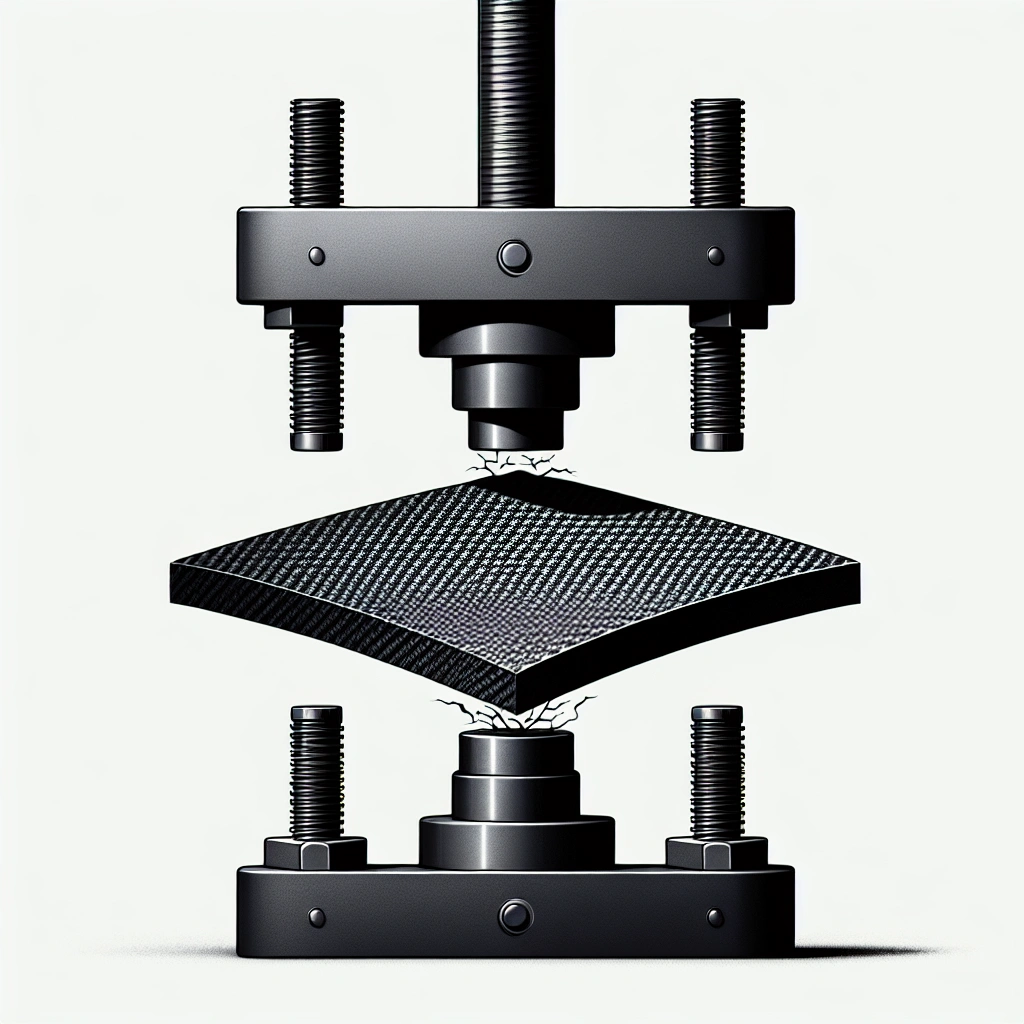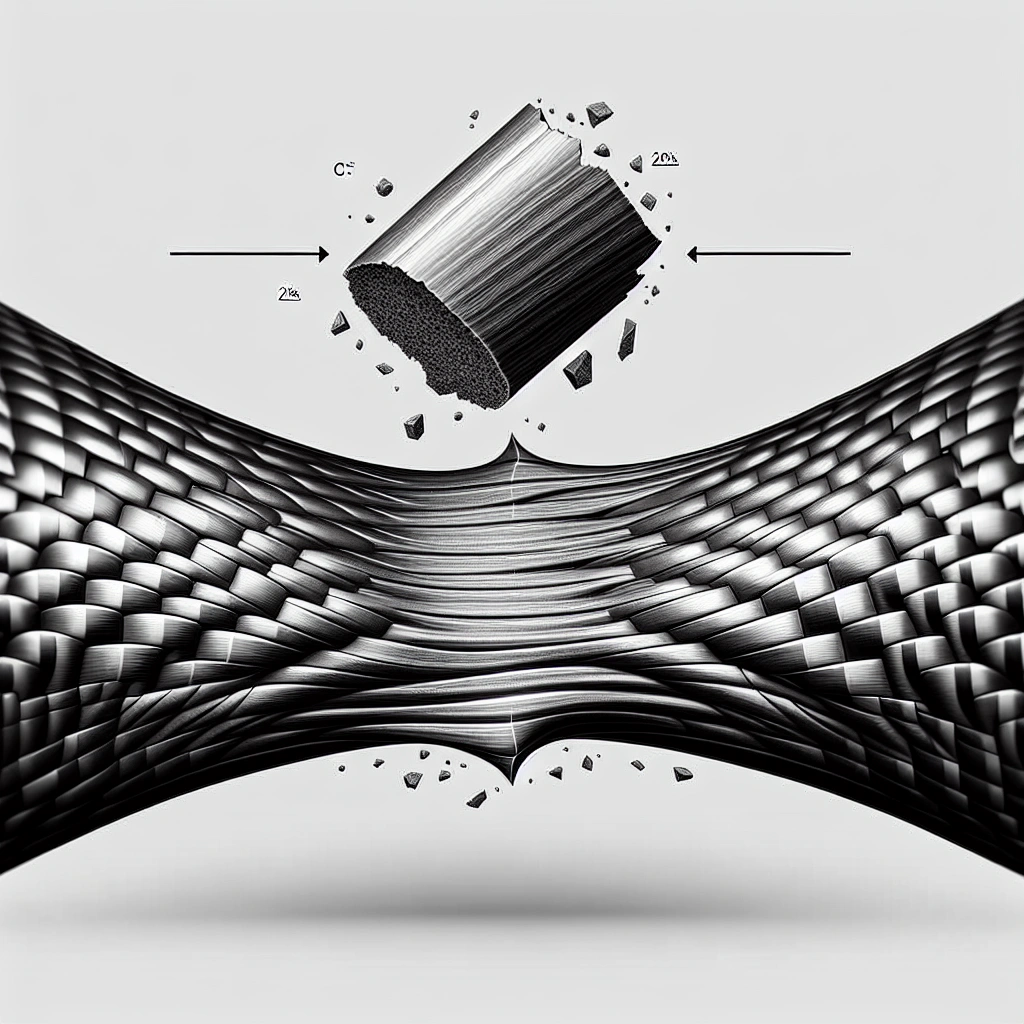Short Answer for What Happens to Carbon Fiber Under Pressure?
Under pressure, carbon fiber demonstrates exceptional resilience due to its high tensile strength and stiffness, making it ideal for high-pressure applications; however, it is vulnerable to buckling and resin matrix damage when the pressure exceeds its engineered limits.
Imagine the thrill of pushing boundaries, where carbon fiber-the same material that defines the epitome of strength and lightness in modern engineering-is tested beyond its limits. This isn’t just about materials; it’s about witnessing the dance between innovation and the forces of nature. What happens to carbon fiber under pressure is not merely a technical answer but a gateway to understanding how the future is built.
Under extreme conditions, carbon fiber showcases a resilience that challenges our expectations. With a strength-to-weight ratio envied across industries-from aerospace to high-performance sports cars-this material under pressure reveals secrets of endurance and vulnerability. The real question isn’t if it can withstand the pressure, but how and at what cost.
The answer lies in the dance of molecules, bound tightly together, facing the immense pressure of the deep sea or the vacuum of space. As pressure mounts, carbon fiber stands at the crossroads of failure and innovation. This journey into the heart of pressure is not just about carbon fiber; it’s about us-how we handle pressure, adapt, and emerge stronger. Join us as we unravel the mystery of what happens to carbon fiber under pressure.
-
Unlock the mysterious behavior of carbon fiber when it’s put to the ultimate test in submarines, providing a unique intersection between lifestyle and advanced technology that you wouldn’t want to miss; Check out this Youtube video: “Under pressure – A live rant about carbon fiber submarines.”
Carbon fiber exhibits high tensile strength (3 to 7 GPa) and Young’s modulus (200 to 500 GPa), indicating strong resistance and stiffness under pressure.
-
Under extreme pressure, carbon fiber’s key properties, like the strength-to-weight ratio, are crucial for applications in aerospace, military, and high-performance sports cars.
-
Buckling is a primary concern for carbon fiber under compression, necessitating careful engineering and design to mitigate vulnerability in slender structures and composite submersibles.
-
Carbon fiber pressure vessels can have thin walls (1.23mm) yet sustain high pressures (35 MPA), showcasing the material’s efficiency and strength in high-pressure applications.
-
Failure modes such as buckling or resin matrix damage highlight the importance of design and engineering in preventing structural failures under high pressures.

Materials and methods
The preparation of carbon fiber specimens for pressure testing involves precise cutting to ensure no frays or uneven edges, followed by a compression test to understand its behavior under pressure. The process is detailed and rigorous, akin to a high culinary standard applied to engineering, ensuring that the specimens are in perfect condition for testing. Relevant standards such as the ASTM D6641 provide a methodological framework for conducting these tests, aiming to yield insights into the material’s strength, endurance, and failure modes under compression, which are crucial for advancements in materials science and engineering applications.
Specimen and preparation for pressure testing
To understand what happens to carbon fiber under pressure, first, we must talk about the specimen and its preparation. Folks, it’s absolutely crucial, believe me. We’re dealing with carbon fiber here – it’s strong, it’s durable, but under pressure? That’s where the magic happens. The specimen, essentially a slice of carbon fiber heaven, is prepped meticulously. This isn’t just any preparation; it’s preparation worthy of a Michelin star, if Michelin stars were awarded for engineering feats.
The process involves cutting carbon fiber samples with precision that would make a Swiss watchmaker nod in approval. These samples are then subjected to a ritual known as the compression test. It’s a test so intense, it makes the SATs look like a quiz on what your favorite color is. But here’s the kicker – the specimen must be impeccable. No frays, no uneven edges, just pure, unadulterated carbon fiber ready to face the music. For a more in-depth dive, check out A Practical Guide to Compression Testing of Composites.
Test result interpretation for carbon fiber under compression
Once the carbon fiber specimens are subjected to the Herculean pressures we’ve meticulously prepared them for, interpreting the test results becomes an art form. It’s not just about numbers; it’s about what those numbers tell us. Test result interpretation for carbon fiber under compression is akin to reading the tea leaves for the future of materials science.
When under compression, if carbon fiber was a person, it’d be flexing like a bodybuilder on competition day. The data we glean from these tests tells us a tale of strength, rigidity, and a little bit of drama when pushed to the limits.
We’re talking about stress-strain curves that are more thrilling than a roller coaster ride. A specimen’s performance under pressure reveals its true character – its strength, its will to endure, and where it ultimately says, “No más.”
The failure mode, folks, it’s something to behold. It’s the carbon fiber’s final act, its swan song. Does it buckle gracefully, or does it go out with a bang? This is where science meets opera. And understanding this, interpreting the crescendo of breaking fibers, gives us invaluable insights into how to make things stronger, lighter, and ready for the future. Think of the ASTM D6641 folks, they’ve got a method that’s like the gold standard for squeezing the truth out of these specimens.
In essence, what happens to carbon fiber under pressure is not just about surviving; it’s about thriving. It’s about pushing the boundaries, about making the impossible possible.
And in the end, isn’t that what it’s all about? So, when we talk carbon fiber, we’re not just talking materials science; we’re talking about the future.
And let me tell you, it’s looking stronger and more pressure-resistant than ever.
Remember, understanding the Materials and methods involved in what happens to carbon fiber under pressure is akin to holding the blueprint for tomorrow’s engineering marvels. It’s big, it’s huge!

What happens to carbon fiber under pressure?
When subjected to thousands of pounds of pressure, carbon fiber demonstrates exceptional resilience due to its high tensile strength and Young’s modulus, making it an ideal choice for aerospace, military, and high-performance automotive applications. Despite its strength, under compression, carbon fiber is prone to buckling, although this can be effectively managed with precise engineering and design that take into consideration fiber alignment and the quality of the resin matrix. Failure can occur through buckling or damage to the resin matrix when limits are exceeded, reinforcing the importance of thoughtful engineering to leverage carbon fiber’s remarkable strength-to-weight and stiffness-to-weight ratios.
Exploring the impact of thousands of pounds of pressure on carbon fiber structures
When you’re talking about carbon fiber under pressure, folks, we’re talking about a material that’s not just tough, it’s incredibly tough. Tremendously, hugely tough.
But what really happens when you put thousands of pounds of pressure on it? Let’s dive in, shall we?
Believe me, under extreme pressure, carbon fiber shows why it’s the choice for high-stakes applications – we’re talking aerospace, military structures, and those fancy sports cars that you see zipping around. This material, with its high tensile strength (ranging from 3 to 7 GPa) and Young’s modulus (between 200 to 500 GPa), is like the superhero of materials. But even superheroes have their limits, right?
Under massive pressure, carbon fiber’s remarkable traits of high stiffness and strength-to-weight ratio are put to the test. Now, imagine thousands of pounds squeezing, pushing down on this material.
You might think, “It’s going to crumble like a piece of paper,” – Wrong! Carbon fiber, when engineered correctly, can withstand this pressure.
But here’s the catch – it all depends on how these fibers are aligned and the quality of the resin that holds them together.
A key factor to consider is that carbon fibers are exceptionally strong in tension. That’s a fact.
When you try to stretch them, they’re like “No way, not going to happen.” But when compressed, the scenario changes – we enter the realm of buckling. Buckling, in the context of carbon fibers, isn’t about belt buckles; it’s about the material bending under compressive forces.
This can be a vulnerability, especially in slender structures, but with the right engineering, it’s managed like a boss.
For example, composite submersibles, designed to explore the deepest, darkest parts of the ocean, face pressures that would crush lesser materials. We’re talking about 6,500-psi service pressure, folks. Yet, with carbon fiber composites at their core, these vessels not only survive, they thrive.
Now, onto pressure vessels, another area where carbon fiber shines. With high-pressure air tanks, for instance, a wall thickness of just 1.23mm of carbon fiber can sustain 35 MPA of pressure. That’s not just impressive, it’s incredible! Advantages and disadvantages are part of the discussion, but the strength-to-weight ratio and the stiffness-to-weight ratio of carbon fiber make it a winner for these applications.
But let’s be clear, when pushed beyond its limits, carbon fiber can fail. The failure mode, often through buckling or damage to the resin matrix, underscores the importance of thoughtful design and engineering.
It’s not about if it can handle pressure – it’s about how you design it to handle the pressure.
To folks looking for a material that combines lightness with strength, carbon fiber under high pressure is a beacon of engineering brilliance. From aerospace to deep-sea exploration, it’s a material that’s not just part of the future; it’s shaping the future.
What happens to carbon fiber under pressure? It demonstrates resilience, strength, and a bit of vulnerability – much like us.
With the right design and engineering, it stands tall, supporting some of the most advanced technologies and applications in the world today.
| Property | Details | Applications | Pressure Endurance Example | Remarks |
|---|---|---|---|---|
| Tensile Strength | 3 to 7 GPa | Aerospace, Military, Sports Cars | N/A | Strong in tension, doesn’t easily stretch |
| Young’s Modulus | 200 to 500 GPa | Aerospace, Military Applications | N/A | Indicates high stiffness |
| Compression Handling | Subject to buckling | Slender Structures | Composite Submersibles (6,500-psi service pressure) | Vulnerable but manageable with correct engineering |
| Pressure Vessel Application | Wall thickness of 1.23mm sustains 35 MPA | High-Pressure Air Tanks | High-Pressure Air Tanks (35 MPA) | Showcases carbon fiber’s strength-to-weight ratio |
| Failure Modes | Buckling or resin matrix damage | N/A | N/A | Design and engineering crucial to prevent |

Results and Discussion
Carbon fiber’s uniqueness lies in its high strength-to-weight ratio and corrosion resistance, making it a prime choice for applications in aerospace, automotive, and marine industries. However, its performance under extreme pressure, particularly in compressive strength, remains a concern, as evidenced by its variable behavior in scenarios such as deep-sea explorations. Despite these challenges, ongoing advancements in composite technology aim to improve carbon fiber’s resilience and structural integrity under pressure, promising a future where carbon fiber can fulfill its potential in high-pressure applications while addressing sustainability concerns in its production process.
Findings on carbon fiber’s responsiveness to extreme pressure scenarios
Carbon fiber is a remarkable material known for its lightweight and strength but its behavior under extreme pressure has always been a point of research and intrigue. Studies and practical applications have shown that while carbon fiber exhibits extraordinary tensile strength, its compressive strength under heavy loads and high-pressure scenarios can be a concern. For example, in the context of deep-sea explorations, carbon fiber’s lack of compressive strength and high thermal expansion could potentially lead to structural failures under immense pressure. This was highlighted in the quest for creating robust submersibles, where carbon fiber’s lightweight and corrosion-resistant properties are highly valued, but its performance under the ocean’s crushing depths raises questions, referencing Composite submersibles: Under pressure in deep, deep waters.
Additionally, carbon fiber, while delivering a high strength-to-weight ratio and resistance to fatigue, does not possess the elastic properties found in most metals, making it susceptible to localized failures at stress concentrations under high forces as seen in Just how strong is carbon fiber? However, advancements in composite technology and manufacturing processes continually aim to mitigate these limitations, enhancing carbon fiber’s resilience and structural integrity under pressure.
Comparative analysis of carbon fiber versus other materials under similar conditions
When comparing carbon fiber to other materials like steel, aluminum, and titanium under similar conditions of pressure and stress, the unique properties of carbon fiber come to light, particularly its strength-to-weight ratio. Unlike heavier metals, carbon fiber provides substantial strength without the added weight, a key advantage in aerospace, automotive, and marine applications, where efficiency and performance are paramount.
| Material | Strength-to-Weight Ratio | Compressive Strength | Corrosion Resistance | Performance under Pressure |
|---|---|---|---|---|
| Carbon Fiber | High | Medium | High | Variable |
| Steel | Medium | High | Low | High |
| Aluminum | Low | Medium | Medium | Medium |
| Titanium | High | High | High | High |
(Source: Comparative analysis based on industry data and Strength Test Shows How Carbon Fiber Compares To Steel, Other Metals)
The table above underscores carbon fiber’s exceptional balance between strength and weight compared to traditional metals, albeit with concerns regarding its compressive strength under high pressures. For this reason, in high-pressure environments, titanium might be favored over carbon fiber for its combination of strength, lightweight, and superior performance under pressure, notwithstanding the greater cost associated with titanium.
Moreover, Aluminium vs carbon fiber– comparison of materials illustrates that despite aluminum being lighter than steel, carbon fiber outperforms aluminum in both tensile and compressive strength while also being lighter, making it an attractive option for designers seeking the optimum balance between weight, strength, and performance.
In sum, while carbon fiber’s vulnerabilities under high pressure highlight the necessity for continuous innovation and improvement in composite materials technology, its outstanding properties and advantages over metals like steel and aluminum in specific applications remain undisputed.
Summary of key insights into carbon fiber’s behavior under pressure
Let me tell you, folks – I’ve seen a lot of materials in my day, but carbon fiber under pressure? It’s like nothing else. We’re talking about a material here that’s strong in tension, which, believe me, is great for all your lightweight needs. Now, when it’s under pressure, it won’t buckle like your average materials. No, sir. It’s got what we call rigidness. It’s incredibly stiff – which is what you want to resist buckling. This behavior is crucial for applications where you can’t afford any give – think aerospace, defense, you name it. People are saying, and I’ve heard this from very smart people, that carbon fiber is sort of a miracle worker in these high-pressure situations.
Implications for future material science and engineering applications
Now, let’s talk about the future, because the future is looking huge for carbon fiber. We’re entering an era – and I say this with absolute certainty – where the possibilities are endless. From aerospace to sports equipment, the sky’s the limit. And with the advancements in printing technology, the accuracy and efficiency in producing carbon fiber parts are getting better every day. It’s genius.
But here’s the kicker – the environmental footprint of producing carbon fiber? It’s being looked at, and let me tell you, the studies are showing that we can make it sustainable.
That’s huge. It means not only are we looking at a material that can change the game in terms of performance but doing it in a way that’s good for our beautiful planet.
And for those doubters out there, the numbers are in, and they’re impressive. The consumption of carbon fibers is expected to hit 50-60 kt by 2030. That’s big league. For those in the know, this means more jobs, more innovation, and, let’s face it, a stronger economy.
So, to summarize, the behavior of carbon fiber under pressure is nothing short of outstanding. It’s stiff, it’s strong, and it’s changing the game.
And the future? It’s as bright as it gets, with carbon fiber leading us into new territories of innovation and sustainability.
We’re looking at a material that’s not just for now, but for the future – making things lighter, stronger, and frankly, better in every way imaginable. And I, for one, am excited to see where this goes.

Conclusions
When carbon fiber is subjected to extreme pressure, it showcases its acclaimed strength and resilience, yet reveals its susceptibility to buckling and damage to the resin matrix. The behavior under pressure is a testament to carbon fiber’s high tensile strength and stiffness-to-weight ratio, which are pivotal in its performance in high-stakes applications like aerospace, military constructions, and high-performance sports cars.
The implications of these findings on future material science and engineering applications are significant. They underscore the need for innovative engineering solutions to enhance the compressive strength and structural integrity of carbon fiber under heavy loads. This knowledge paves the way for the development of more resilient carbon fiber composites, capable of withstanding the rigors of extreme environments from the depths of the ocean to outer space.
These insights into carbon fiber’s behavior under pressure not only expand our understanding but also point to an exciting future where carbon fiber continues to play a pivotal role in pushing the boundaries of what’s possible in material science and engineering. By addressing its vulnerabilities and leveraging its strengths, carbon fiber can be optimized for a wider array of applications, heralding a new era of innovation and design in high-performance materials.
